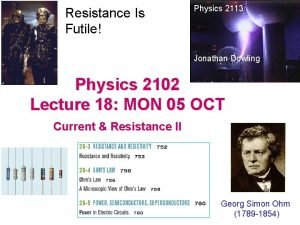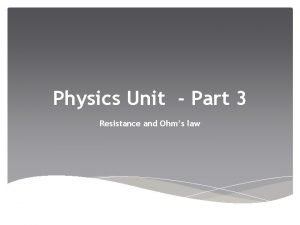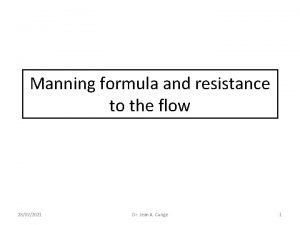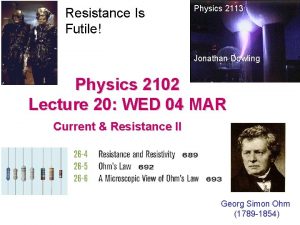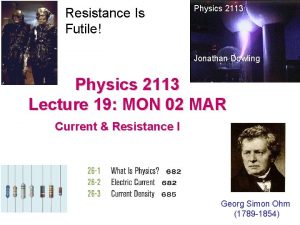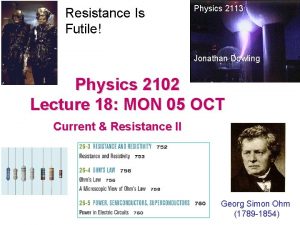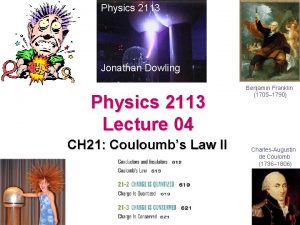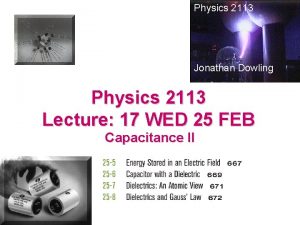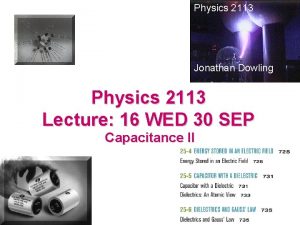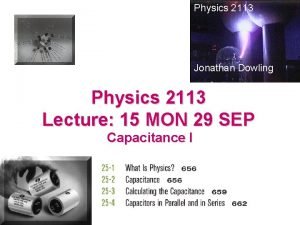Resistance Is Futile Physics 2113 Jonathan Dowling Physics













![L A=πr 2 A Current Density: J=i/A Units: [A/m 2] Resistance: R=ρ L/A Resitivity: L A=πr 2 A Current Density: J=i/A Units: [A/m 2] Resistance: R=ρ L/A Resitivity:](https://slidetodoc.com/presentation_image_h/fc5ac86c12f8e8786db713bff5ccb931/image-14.jpg)





- Slides: 19

Resistance Is Futile! Physics 2113 Jonathan Dowling Physics 2102 Lecture 18: WED 08 OCT Current & Resistance II Georg Simon Ohm (1789 -1854)

Resistance is NOT Futile! Electrons are not “completely free to move” in a conductor. They move erratically, colliding with the nuclei all the time: this is what we call “resistance”. The mechanical analog is FRICTION. The resistance is related to the potential we need to apply to a device to drive a given current through it. The larger the resistance, the larger the potential we need to drive the same current. Ohm’s laws Georg Simon Ohm (1789 -1854) "a professor who preaches such heresies is unworthy to teach science. ” Prussian minister of education 1830 Devices specifically designed to have a constant value of R are called resistors, and symbolized by

Resistivity ρ vs. Resistance R Metal “field lines” These two devices could have the same resistance R, when measured on the outgoing metal leads. However, it is obvious that inside of them different things go on. resistivity: Resistivity is associated ( resistance: R=V/I ) with a material, resistance with respect to a device constructed with the material. Example: A - L V + Makes sense! For a given material:

26. 4: Resistance and Resistivity: The resistivity ρ of a resistor is defined as: The SI unit for ρ is Ω. m. The conductivity σ of a material is the reciprocal of its resistivity:

26. 4: Resistance and Resistivity, Calculating Resistance from Resistivity: Think pumping water through a long hose. It is easier if L is short and A is big (small R). It is harder if L is long or A is small (big R). If the streamlines representing the current density are uniform throughout the wire, the electric field E and the current density J will be constant for all points within the wire.

ICPP The copper wire has radius r. What happens to the Resistance R if you: (a) Double the Length? (b) Double the Area? (c) Double the Radius? What happens to the Resistivity ρ if you: (a) Double the Length? (b) Double the Area? (c) Double the Radius?

Step I: The resistivity ρ is the same (all three are copper). Find the Resistance R=ρL/A for each case: Step II: Rank the current using V=i. R or i=V/R Ranking is reversed since R is downstairs.

Example Two conductors are made of the same material and have the same length. Conductor A is a solid wire of diameter r=1. 0 mm. Conductor B is a hollow tube of outside diameter 2 r=2. 0 mm and inside diameter r=1. 0 mm. What is the resistance ratio RA/RB, measured between their ends? A R=ρ L/A B AA=π r 2 AB=π ((2 r)2 -r 2)=3πr 2 RA/RB= AB/AA= 3 LA=LB=L Cancels

Example, A material has resistivity, a block of the material has a resistance. :

26. 4: Resistance and Resistivity, Variation with Temperature: The relation between temperature and resistivity for copper—and for metals in general— is fairly linear over a rather broad temperature range. For such linear relations we can write an empirical approximation that is good enough for most engineering purposes:

Resistivity and Temperature Resistivity depends on temperature: ρ = ρ 0(1+α (T–T 0) ) • At what temperature would the resistance of a copper conductor be double its resistance at 20. 0°C? • Does this same "doubling temperature" hold for all copper conductors, regardless of shape or size?

Resistance is NOT Futile! Electrons are not “completely free to move” in a conductor. They move erratically, colliding with the nuclei all the time: this is what we call “resistance”. The mechanical analog is FRICTION. The resistance is related to the potential we need to apply to a device to drive a given current through it. The larger the resistance, the larger the potential we need to drive the same current. Ohm’s laws Georg Simon Ohm (1789 -1854) "a professor who preaches such heresies is unworthy to teach science. ” Prussian minister of education 1830 Devices specifically designed to have a constant value of R are called resistors, and symbolized by

26. 5: Ohm’s Law:
![L Aπr 2 A Current Density JiA Units Am 2 Resistance Rρ LA Resitivity L A=πr 2 A Current Density: J=i/A Units: [A/m 2] Resistance: R=ρ L/A Resitivity:](https://slidetodoc.com/presentation_image_h/fc5ac86c12f8e8786db713bff5ccb931/image-14.jpg)
L A=πr 2 A Current Density: J=i/A Units: [A/m 2] Resistance: R=ρ L/A Resitivity: ρ depends only on Material and Temperature. Units: [Ω • m]


Example An electrical cable consists of 105 strands of fine wire, each having r=2. 35 Ω resistance. The same potential difference is applied between the ends of all the strands and results in a total current of 0. 720 A. (a) What is the current in each strand? i=I/105=0. 720 A/105=[0. 00686] A (b) What is the applied potential difference? V=ir=[0. 016121] V (c) What is the resistance of the cable? R=V/I=[. 0224 ] Ω

Rd = 1. 0 x 105Ω im = 1 x 10– 3 A Rw = 1. 5 x 103Ω im = V 1 = im. Rd i 1 = V 1/Rw V 2 = im. Rw

Example A human being can be electrocuted if a current as small as i=100 m. A passes near the heart. An electrician working with sweaty hands makes good contact with the two conductors he is holding. If his resistance is R=1500Ω, what might the fatal voltage be? (Ans: 150 V) Use: V=i. R

 Jonathan dowling
Jonathan dowling E=q/ae0
E=q/ae0 Specific resistance
Specific resistance Comp 2113
Comp 2113 Art.2113 cc
Art.2113 cc Afi 36 2113
Afi 36 2113 Shawn dowling
Shawn dowling Dowling optical
Dowling optical Dowling roundabout
Dowling roundabout International human resource management dowling 6th edition
International human resource management dowling 6th edition The most dangerous game vocabulary
The most dangerous game vocabulary Define futile care
Define futile care Chapter 26 the futile search for stability
Chapter 26 the futile search for stability Chose futile
Chose futile After hours of futile debate
After hours of futile debate Cartridge filter design calculation
Cartridge filter design calculation What is a force that opposes motion through direct contact
What is a force that opposes motion through direct contact Resistance physics
Resistance physics Holmes law electricity
Holmes law electricity Manning's formula
Manning's formula


